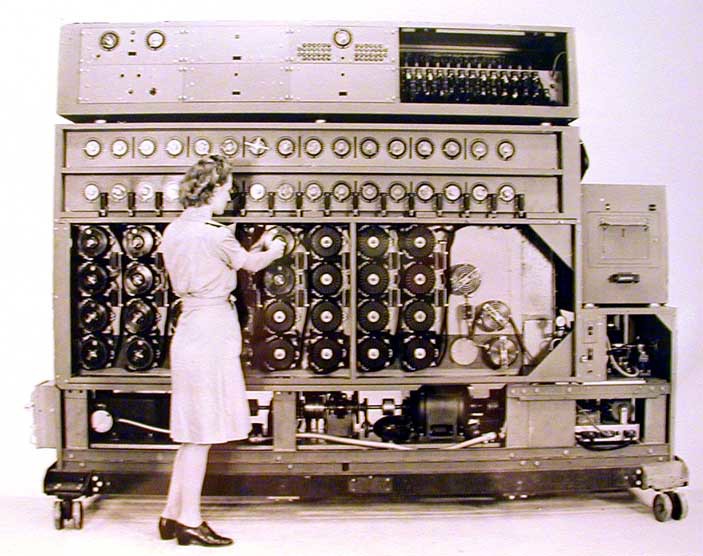I just finished reading The Secret in Building 26: The Untold Story of How America Broke the Final U-boat Enigma Code. What a fascinating read! I’ve written before about the UK’s contribution to code breaking during WWII (Neglect of Bletchley condemned and Bletchley Park Update), but this is the first time I learned about some of the details of the US contribution. I always thought the majority, if not all, of the work was handled by the British, but this book details how it was much more of a partnership between the British and Americans. Most of this stuff is only recently declassified, and most is still classified. However, the information available is a great introduction to the dawn of the electronic computer.
Computers were born from two basic military needs. First, I want to blow up the other guy so I need to calculate the ballistic trajectory of my shells. Second, I want to read and learn my enemy’s secrets. The first (ballistics) is a fairly straight forward calculation (although a lot harder than you think), but it is such that you can create tables and distribute rather than recalculating every time. It’s not exact, but it gets you pretty close. The second (code breaking) is much harder because the codes and the techniques are changing all the time. This book covers those americans working in Building 26 of the NCR Corporation. With their British counterparts, they help cracked the Nazi Enigma machine, allowing the allies to shorten the war.
What is so interesting about this story? As a computer and math geek, I love learning how computing was born. Most importantly, I’m interested in the people that made it happen. For example, one the foremost code breakers of the time was Agnes Driscoll. In the 20’s and 30’s is was not very common for woman to hold such a high scientific and strategic position. “Madam X” or “Ms Aggie” as she was referred to took a lot of heat because she was a woman, but damn she held her own and is credited with breaking several “unbreakable” codes — all by hand! My favorite story of the crap she had to put up with was when a gung-ho Navy officer dared question her application to renew her security clearance. The young officer barged in and yelled “Ma’am, in this section where you are required to list five references, you have listed the names of five admirals. You are supposed to list the names of people you know well.”
Driscoll looked up at the young man with a squint in her eye and said, “Sonny, I knew all of them when they were ensigns and lieutenants, and if you don’t straighten up, I’m going to tell them to never promote you.”
Another interesting person was Joseph R. Desch. He was the lead for the entire effort. Most of the pressure fell on this man, and no one ever knew what he did. Never mind 14-hour days, 7 days a week, and often 7:30AM to 2:30AM the next day, 7 days a week for months at a time. All of this work to develop a machine call a Bombe. The German Navy’s Enigma machine had 2.0 x 10145 ciphering possibilities compared to 1.0 x 1080 atoms in the known universe, and it was the Bombe’s job to crack the code. It couldn’t do it alone, but by the end of the war through a combination of Bombes, cribs, lax German procedures, and good guesses, the teams could read German messages often before the German recipients did. Fascinating stuff.
In 1947, Joe Desch received the National Medal of Merit in a secret ceremony for his work in developing the U.S. Bombe. Unfortunately, no one ever knew until after his death why he had the highest civilian honor for wartime service. Not even his family had a clue until the 90’s.
Don’t forget Alan Turing was part of the effort to build the British Bombe. You all recognize the name Turing, right?
If you are at all interested in world and computing history, I highly recommend this book. If you do read the book, don’t skip the acknowledgements. It’s impressive to see how much went into gathering the information for this book.

Above is a US Bombe machine with a WAVE operator from 1943. The US Bombe machines were 10 feet wide, 7 feet tall and about 2 feet deep. They weighed over 2 and 1/2 tons. The American machines used mechanical relays, vacuum tubes, various motors and clutches, and were run by the women of the WAVE section (Women Accepted for Volunteer Emergency Service) of the United States military.
Leave a Reply